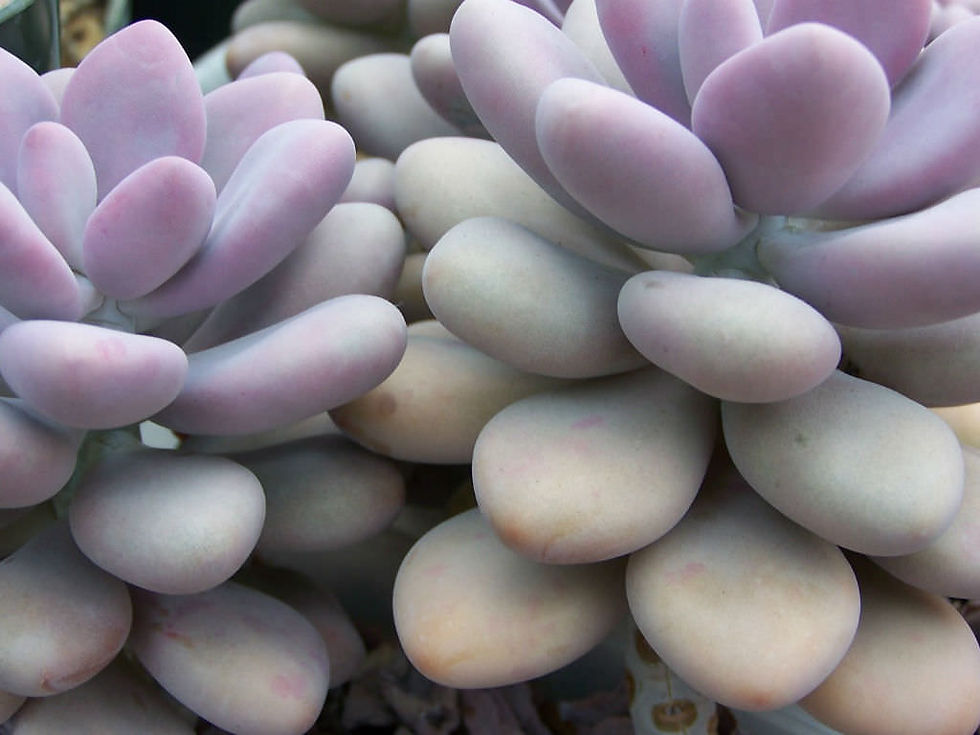Graptopetalum Genus The Ultimate Guide to Growing and Caring for Graptopetalum Succulents
- Elevated Succulents

- Sep 22
- 3 min read
Graptopetalum succulents, commonly known as "ghost plants," offer an eye-catching addition to any succulent collection. With their unique rosette shapes and pastel colors, these hardy plants are not only visually appealing but also easy to care for. In this guide, you will learn everything about growing and caring for Graptopetalum succulents, from their ideal growing conditions to effective propagation techniques.
Understanding Graptopetalum Succulents
Graptopetalum is a genus of succulent plants that are native to Mexico. Part of the Crassulaceae family, they are closely related to Echeveria. These plants are recognized for their fleshy leaves that form rosettes, displaying a range of colors from pale green to lavender and even soft pink.
Graptopetalum are popular because they require minimal maintenance while providing substantial visual appeal. These plants thrive in well-draining soil and need little water, making them an excellent choice for both beginners and seasoned gardeners.
Ideal Growing Conditions
Light Requirements
Graptopetalum succulents flourish in bright, indirect sunlight. Though they can handle some direct sunlight, excessive exposure can lead to scorched leaves. Ideally, position your plants where they can soak up at least six hours of light daily. A south or west-facing window works best.
Soil Type
Selecting the right soil is vital for healthy Graptopetalum succulents. A well-draining cactus or succulent mix is perfect, preventing excess water from lingering around the roots. Alternatively, you can create your own mix by blending potting soil with perlite or coarse sand for better drainage.
Temperature and Humidity
These succulents thrive in temperatures ranging from 65°F to 80°F (18°C to 27°C). They can tolerate cooler temperatures but should be kept away from frost. Graptopetalum prefer low humidity, making them suitable for dry indoor environments. For example, a humidity level below 40% helps them grow best.
Watering Your Graptopetalum Succulents
Understanding the watering needs of Graptopetalum is crucial for their care. These plants are drought-tolerant and prefer the soil to dry out completely between waterings.
Watering Schedule
During the growing season in spring and summer, water your Graptopetalum every two to three weeks. In the fall and winter, reduce watering to once a month or even less, as the plants enter dormancy.
Signs of Overwatering
Overwatering is a common mistake with succulents. Signs include yellowing leaves, mushy stems, and a foul smell from the soil. If you see any of these signs, it’s essential to allow the soil to dry out fully and adjust your watering routine.
Fertilizing Graptopetalum Succulents
Graptopetalum succulents do not require frequent fertilization, but adding nutrients during the growing season can help them flourish.
Choosing the Right Fertilizer
Opt for a diluted, balanced fertilizer specifically made for succulents and cacti. Fertilizing once a month during the spring and summer can significantly boost growth. However, refrain from fertilizing in the fall and winter when the plants are dormant.
Propagating Graptopetalum Succulents
Propagating Graptopetalum succulents is a satisfying process that can expand your collection or allow you to share with friends. The two primary methods are leaf cuttings and offsets.
Leaf Cuttings
Select a Healthy Leaf: Choose a plump, healthy leaf from the parent plant.
Let it Callous: Set the leaf aside for a few days until the cut end forms a callous.
Plant the Leaf: Insert the calloused end into well-draining soil and lightly mist it.
Water Sparingly: Keep the soil slightly moist, not wet, until roots develop, which usually takes about 2-3 weeks.
Offsets
Graptopetalum succulents often produce offsets or "pups" that can easily be removed and replanted.
Remove the Offset: Carefully twist or cut the offset from the parent plant.
Let it Callous: Allow the offset to dry for a few days.
Plant the Offset: Place it in well-draining soil and water sparingly until established, generally within a few weeks.
Common Pests and Problems
Graptopetalum succulents are generally resilient, but they can attract pests like mealybugs and aphids.
Identifying Pests
Keep an eye out for signs of pests on your plants. Look for white, cotton-like masses indicating mealybugs or small green insects representing aphids.
Treatment Options
If you discover pests, treat your plants with insecticidal soap or neem oil. Always follow the instructions on the product label for effective application. Early intervention can save your plants from severe damage.
Final Thoughts
Graptopetalum succulents are an excellent choice for anyone wanting to enhance their home or garden. With their unique aesthetics and low care requirements, they suit both novice and skilled gardeners. By maintaining the right conditions, understanding their watering needs, and occasionally fertilizing, you can enjoy these delightful succulents for a long time.
Whether you decide to propagate or admire their beauty, Graptopetalum succulents will undoubtedly add vibrancy and joy to your space.


_edited_edited_edite.png)




Comments